David Stairs

View from atop the Middle Sister in the west central Oregon Cascades reaches 100 miles north to Mt. Hood.
On a recent drive across country I was thinking about what the land must have looked like two hundred years ago. Lewis and Clark described an “Eden” of endless vistas and limitless game, a land practically untouched by human hand since time immemorial. It must have been an amazing sight.
In its place there now exists trailer parks and dry-land farms, strip mines and wind farms, donkey jacks and factory farms. The Oregon Trail, which the highway follows, is barely recognizable. Rampant mediocrity masquerades as branded quality on Interstate 80, predictably bad food and overpriced gas stations and cheaply built motels. Eden has been populated by a society of maniacs rushing madly about in their noisy, dirty machines, leading frantic lives of increasingly ungratified desperation. No one seems to notice. My destination was Portland, capital of Ecotopia, also known as “The City That Works,” although it must share that designation with several other cities, most notably Chicago. Arguably the most beautiful city of the lot, Portland is therefore the one place in the country where people seem to care about their surroundings. And yet, even as young people flock there, Oregonians are divided on the environment, with those in the western third of the state, and by no means all of them, much more willing to suffer regulation than those in the eastern half. There is also the rather large matter of ambivalence about prior damage done.
Before the Tom McCall years during the early environmental movement of the ’70’s, Oregonians had been just as guilty of clear-cutting forests and damming wild and scenic rivers as any Americans. The massive dams on the Columbia at John Day, The Dalles, and Bonneville have been supplying cheap power at the expense of salmon and scenery for almost eighty years, and the older dams on smaller rivers like the Rogue have only recently been dismantled. That the Oregon coast remained public domain is a small miracle. This would seem to suggest that, even in their most livable city, Americans are only halfhearted about protecting their environment. The image Portland projects, as the only American city with an eponymous TV series, can be misleading. As a western and therefore young city, Portland does not have the problems of old industrial towns like Detroit, but it is cursed with the same interstate highway planning debacle that, in the aesthetically blind 1950’s, cut right through most American cities. Interstate 84 connects with Interstate 5 right in the heart of town. Engineering marvels, like the Vera Katz East Bank Esplanade, which gives cyclists, joggers, and pedestrians a traffic-free thoroughfare, adds further injury to an already overdeveloped waterfront.
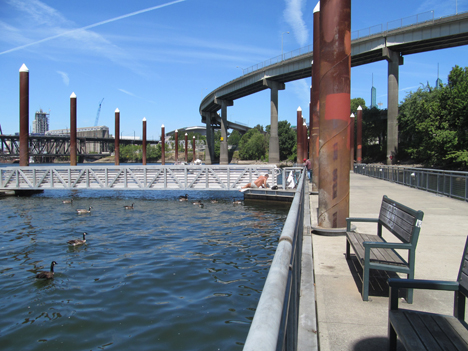
The Vera Katz Memorial Eastbank Esplanade runs alongside I-5 and is built right over the water in places.
With the beautiful but damaged Willamette river running right through town, Portlanders have something to feel guilty about. Perhaps that’s why Portland is bike crazy. Whole families travel to events by bike, and large groups pedal together from bar to bar on human-powered vehicles like the Pedalounge. Yet, despite aggressive cyclists sharing city streets with vehicles, Portland is still plagued with far too many cars in too little space. Clever initiatives like Car2Go, a rental service where Smartcars are left in various neighborhoods and hired online, only add to the crisis in street-level parking. Narrow streets are reduced to one lane in neighborhoods where driveways are limited and families own more than one vehicle.
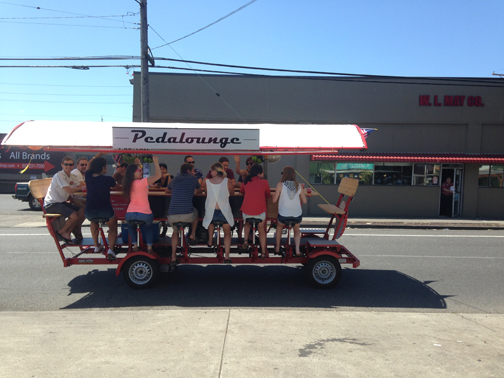
The Pedalounge, a 16-person human-powered vehicle for bar crawling parties.
There’s great love for food of all kinds in Portland, as evidenced by the explosion of food carts and trailers vending every variety of ethnic street food imaginable. And good restaurants abound to satisfy the demands of “foodies” and “fashionistas” alike, but, even given manifold examples of “quality of life,” it’s difficult to escape the fact that, in modern cities, population density results in the deterioration not the improvement of life. An example of this might be former Portland Mayor Sam Adams’ decision to save money by reducing the number of waste pick-ups per month. This relieved stressed city budgets to an extent, but also increased the presence of rodents around trash canisters and compost piles. Nature, evicted from Eden, does not take long to re-establish her hegemony.
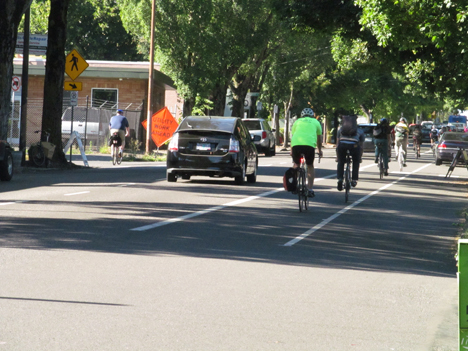
Each day large numbers of Portlanders bicycle commute to work. Note the passing Prius, now a commonplace.
Older neighborhoods, like Boise-Elliot in north central Portland, struggle to survive amid constant commercial encroachment. Many of the homes in this area have been renovated in the last quarter century, but the erosion of the neighborhood on the fringes of different zoning is evident and ugly. Then again, while inside the neighborhood feels green and insular, it doesn’t take much effort to realize that three blocks away traffic is gridlocked on I-5, the major highway in this part of the world.
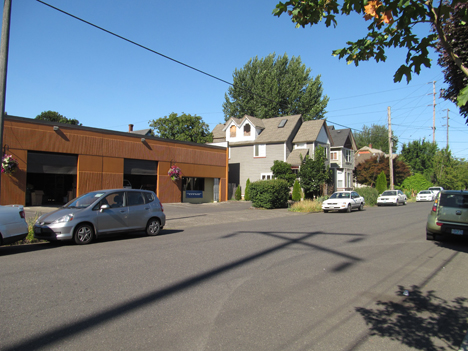
The Boise-Eliot neighborhood, a residential island surrounded and eroded by commercial zoning on all sides.
Which sort of begs the question, is any American city, even the most green, a healthy or sane place to live? Or have we, in our incessant pursuit of technical progress and economic growth, finally succeeded in adapting to dehumanized living conditions? The first question is easier to answer. A certain amount of insanity is required to live in any metropolitan area. One day my daughter Maya spent an hour bucking rush hour traffic to drive her son Ethan across Portland to a birthday party at 4pm. This seems to be the norm for cities of a half million or more. A few days later while in Eugene, Oregon’s second largest but much smaller city, I was able to drive across town between appointments at 3:30pm in ten minutes. In other words, size does matter. Dehumanizing living conditions are another issue, one that has haunted human settlements since the ancient world. Mid-nineteenth century London was as damaged by the polluting effects of dense population as mid-twentieth century Pittsburgh was by industry. I’ve lived in Bangalore, India, a city of 10 million, and I can assure you the traffic was awful. Humans have, for thousands of years, been willing to trade the calm of village life for the questionable opportunities of urban living. A resident of a modern city, even one as ostensibly “green” and “responsible” as Portland, has to be willing to look the other way when it comes to high food prices, tight housing, traffic congestion, noise pollution, and poor air quality, and these are only the obvious sacrifices.
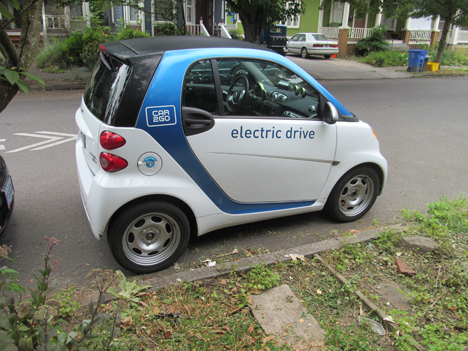
Leaving rentable Smartcars parked on neighborhood streets seems like a clever distribution idea until one recognizes the acute shortage of on-street parking.
The trappings of responsible urban planning like water management, zoning and building height restrictions, green belting, and brownfield restoration are the minimum requirements for sane living. Until people are willing to sacrifice the convenience of personal vehicular transport, limiting highways and creating vehicle-free zones, and planting more trees than pouring concrete and laying asphalt, even the best planned modern cities will remain stressful environments. We can never return to the bucolic paradise that existed before the founding of American cities. We can only read the accounts of what our continent was like before urbanization and not fool ourselves that our efforts to make cities “livable” are, at the moment, anything better than compromises. Human beings are what are categorized as “small-group social primates.” Cities, with their crowded millions, require an adaptation from our origins that we are constantly trying to adjust. If I were to sum up my observations of America’s greenest city I would have to say that, at best, we have become satisfied with failure. Lewis and Clark, who explored the area in the winter of 1804-05 and for whom a well-known Portland college is named, might have had a stronger response… they would have been outraged.
David Stairs is the founding editor of Design-Altruism-Project.











Leave a Reply
You must be logged in to post a comment.